Accidentally Sickening Your Pet
Dr. Ahna Brutlag, Pet Poison Helpline
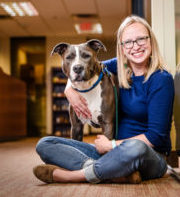 The Senior Veterinary Toxicologist at the Pet Poison Helpline wants you to know what household toxins can fatally sicken your pets. Dr. Ahna Brutlag warns that pesticides and bait traps can kill more than bugs and mice. She also says even pet safe anti-freeze can be harmful.
The Senior Veterinary Toxicologist at the Pet Poison Helpline wants you to know what household toxins can fatally sicken your pets. Dr. Ahna Brutlag warns that pesticides and bait traps can kill more than bugs and mice. She also says even pet safe anti-freeze can be harmful.
Dr. Ahna Brutlag tells us that they receive many calls regarding pesticides on lawns that can harm dogs and cats. A lot of people use pesticides, so therefore you're going to have a lot of exposure, which leads to a lot of questions. Most of the pesticides that are used nowadays on lawns are for the most part pretty safe, but there still are a few standouts that we really need to worry about.
The ones that Dr. Brutlag worries about are typically not the herbicides, it's more of the insecticides that are put on lawns. One that they see particular problems with dogs is the insecticide granules with the active ingredient bifenthrin. If you put this on your lawn and an animal walks across it and licks their feet, they typically can't get too much in that kind of exposure. However, if the owner left that bag out and the dog got into the bag, or they had a little pile on the yard trying to treat an anthill or something like that and the dog were to eat that pile of granules, then we can really see some pretty significant neurological effects.
The rodenticide d-CON changed their formula by getting rid of the anticoagulants and adding vitamin D. So do we no longer need to worry about this rodenticide with our cats and dogs? Dr. Brutlag explains that yes, as anything that can poison a mouse or a rat can also poison a cat or a dog. We don't have things that just poison mice and spare other mammals. So the big change here is that d-CON historically has always used blood thinner type rodenticides in their products. What veterinarians liked about that is that you never want to see an animal get into this stuff, but if they do, there's a very safe, easy, real cheap and easily reliable antidote that's available. All veterinarians have this antidote at their disposal. So even if a dog did get too much of the old d-CON, which was the blood thinner type, they could be started on the antidote and chances are they would do very well.
d-CON then switched to cholecalciferol, which is also vitamin D3. This is the same kind of vitamin D people make from sunshine. Animals need to eat vitamin D because of their fur. However, an overdose of vitamin D can be pretty hard on the kidneys as well as the heart. It can also cause other issues and it's harder to treat those in a poisoning scenario than it was the old anticoagulant baits. Dr. Brutlag explains that if a dog or cat gets into this formula with vitamin D, there are medicines that they can give and they can also do things like IV fluids.
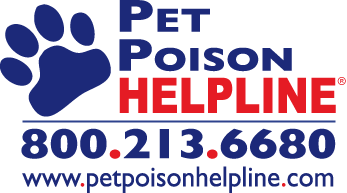 When a cat or dog eats an overdose of vitamin D, their blood calcium levels and their blood phosphorous levels get too high. When your calcium and phosphorus get too high, those molecules combine and they form minerals. Just think of these little guys kind of turning to stone. This puts mineral deposits in the kidneys, mineral deposits in the heart and those mineral deposits cause organ damage.
When a cat or dog eats an overdose of vitamin D, their blood calcium levels and their blood phosphorous levels get too high. When your calcium and phosphorus get too high, those molecules combine and they form minerals. Just think of these little guys kind of turning to stone. This puts mineral deposits in the kidneys, mineral deposits in the heart and those mineral deposits cause organ damage.
In this scenario, veterinarians want to get that blood calcium level back down to a normal level. They do that by using a lot of IV fluids. There are also some specific drugs that you can give that are helpful in most cases. However, these drugs are given in the hospital and are IV medications. These animals then usually end up spending more time in the hospital just simply to get all the medications that they need versus with the anticoagulants where they usually only had to spend maybe a day or two at the most in the hospital, unless it was a very, very severe case.
Did d-CON switch to their new formula with the vitamin D as a way to help save animals and it's having the reverse effect, or was this just something that they just did not even caring about the other animals? Dr. Brutlag explains that d-CON made this change because they had to comply with EPA regulations. The EPA changed the rodenticide laws. What they said is if you're going to have a rodenticide that is sold for use in someone's house, called consumer rodenticide bait, it can have basically one of three types of ingredients. It can have the old school anticoagulants, it can have vitamin D or it can have something called bromethalin, which is a neurotoxicant for which there is absolutely no antidote.
d-CON said they were going to try and keep the old school anticoagulants. However, there was a lot of hesitancy there because those had been tried in the past and they weren't as effective. So they tried coming up with "a new old school," but the new anticoagulants didn't work very well. So they were faced with a choice of using vitamin D or using bromethalin. They ended up choosing what they felt was the safer option, which is vitamin D, because at least there are more treatment options for it than bromethalin.
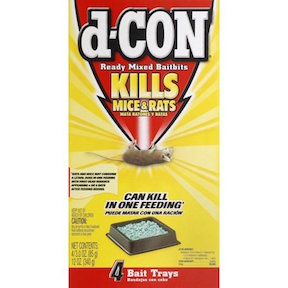 Rodenticides are usually used in the warmer months, but now that we are coming up to winter we are putting salt on the sidewalk and even antifreeze in the car. There are some salt products that are safer for your pets than others. Just read the labels to make sure you get something pet friendly and less irritating to their paws than plain salt. And when it comes to antifreeze, both cats and dogs lick to the stuff up, so is there pet safe antifreeze? Dr. Brutlag explains that there are a couple different brands that make what's called "pet safe antifreeze." The difference is that these are made from a chemical called propylene glycol, not from the traditional antifreeze, which is ethylene glycol. These are cousin chemicals, but ethylene glycol causes much more damage to the kidneys then propylene glycol does. What this means is a cat or dog could drink more propylene glycol compared to traditional antifreeze before it would get sick. So they can still drink enough to get sick, but it takes a lot more of it to cause an issue. Dr. Brutlag recommends using these if you are a pet owner.
Rodenticides are usually used in the warmer months, but now that we are coming up to winter we are putting salt on the sidewalk and even antifreeze in the car. There are some salt products that are safer for your pets than others. Just read the labels to make sure you get something pet friendly and less irritating to their paws than plain salt. And when it comes to antifreeze, both cats and dogs lick to the stuff up, so is there pet safe antifreeze? Dr. Brutlag explains that there are a couple different brands that make what's called "pet safe antifreeze." The difference is that these are made from a chemical called propylene glycol, not from the traditional antifreeze, which is ethylene glycol. These are cousin chemicals, but ethylene glycol causes much more damage to the kidneys then propylene glycol does. What this means is a cat or dog could drink more propylene glycol compared to traditional antifreeze before it would get sick. So they can still drink enough to get sick, but it takes a lot more of it to cause an issue. Dr. Brutlag recommends using these if you are a pet owner.
However, if you have any kind of antifreeze product in your garage and your home, keep it out of reach because there are so many situations where a dog gets a hold of a bottle full of liquid, especially bigger dogs, and they want to chew on it, which is how they get exposed. They can also get exposed while someone's changing out their antifreeze and might have a bucket of used antifreeze sitting there. The dog then just sticks it's head in the bucket and licks away.
Dr. Brutlag also recommends checking your garage or any place you store old chemicals. She explains that some of the older chemicals are a lot worse for our pets than the ones of today. These include products for lawns and gardens, pests and even pool chemicals. She says you should dispose of them properly just to be safe.
Visit Website
Psychologist Tells Us What Pets Want From Their Owners
Dr. Zazie Todd, Psychologist
 Ever wonder how your pet sees the world? There's an entire branch of science devoted to figuring that out. Psychologist Dr. Zazie Todd has been studying the techniques guardians use to better their relationship with their pets.
Ever wonder how your pet sees the world? There's an entire branch of science devoted to figuring that out. Psychologist Dr. Zazie Todd has been studying the techniques guardians use to better their relationship with their pets.
Many humans see psychologists on a regular basis. But what about our pets, should they be seeing a psychologist as well? Dr. Zazie Todd has a PhD in human psychology. However, since 2012, she has been writing a blog called Companion Animal Psychology, which is all about animals.
Dr. Todd has been researching what science tells us about dogs and cats and how to keep them happy. At the same time, she's been very lucky because she graduated with honors from the Prestigious Academy for Dog Trainers, which is known as the Harvard of dog trainers. She also has a certificate of feline behavior with international cat care. Dr. Todd is used to working with dogs and cats that maybe have a few issues.
So what can you do for your cat or your dog to make them happier? According to Dr. Todd, one of the biggest things you can do is to train them with positive reinforcement. What that means, is that if they do the thing you want them to do, you give them some positive reinforcement, which often will be food. Food is usually the best thing to use. This applies to cats as well as dogs.
There are several reasons this is good. One is that a lot of people unfortunately train their dogs or their cats using punishment. Maybe they use electronic shock collars, choke chains or prong collars. They might even roll their dog. If they have a cat, maybe they squirt them with water if they do something they don't like.
As far as dogs go, Dr. Todd explains that there's quite a big body of research that shows that there are risks to using punishment as a training method. The risks mainly have to do with causing fear or aggression in your dog. Most of the studies on dogs were done with surveys where they asked people how they trained their dog, what the results were and did their dog have any behavior problems. There have also been experimental studies where they've observed people training dogs to see what the results are and their body language.
While there are risks to using punishment, on the other side, there are some benefits to using positive reinforcement in terms of cognitive enrichment. Many dogs perhaps get a bit bored some of the time. Maybe cats do too, if you have an indoor cat. Training with positive reinforcement is a really nice way to provide enrichment for your dog or cat because it's a fun activity.
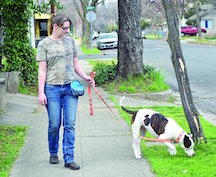 There is a really nice study that shows that dogs like to successfully solve problems and they prefer to solve the problem and earn a reward than actually just to be given the reward in the first place.
There is a really nice study that shows that dogs like to successfully solve problems and they prefer to solve the problem and earn a reward than actually just to be given the reward in the first place.
Btu what if you have a fearful dog in certain situations, should you just avoid those situations altogether or make your dog work through it? Dr. Todd says it depends a little bit on what the situation is, because some situations you can avoid very easily and then your dog never has to deal with being frightened in those situations. But you can also train a dog to not be afraid.
There's a technique called desensitization and counter conditioning, which basically breaks the situation down into nice easy bits where your dog is never actually going to feel afraid. Every time they become fearful, you give them some really nice food reward, like a piece of chicken, so that they're actually going to learn to like the thing they are afraid of. Ultimately over time that's a very, very successful way of dealing with fear. But in some cases for a dog with fear, they might benefit from seeing a veterinarian and discussing whether or not medication will help. In some cases, medication can be very helpful too.
So is it true that a tired dog is a happy dog? In terms of physical exercise, Dr. Todd thinks dogs definitely do need physical exercise just like we do. There is also a big problem of overweight and obesity in dogs at the moment, which is similar to the situation for people. So exercise is important and helpful to help keep a dog's weight down and again to give them something to do. You can exercise them by playing fetch, going for off- leash walks or long walks on leash.
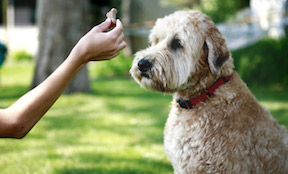 If you're taking them on leash, the important thing to remember is to give your dog lots of sniffing opportunities, because the walk is for them really and not for you. A dog's nose is such an important organ for them. We all know that they like to sniff and they're always finding things to sniff. When you take them for a walk, think of it as a "Snifari." Dr. Todd didn't coin that, but she loves it because it conjures up this idea that the walk is for the dog to find lots of really interesting smells and its not just physical exercise. Through their noses, they can read where other dogs have been, what's happened in the neighborhood and who else has been by, among other things. It's really nice for them to have those opportunities.
If you're taking them on leash, the important thing to remember is to give your dog lots of sniffing opportunities, because the walk is for them really and not for you. A dog's nose is such an important organ for them. We all know that they like to sniff and they're always finding things to sniff. When you take them for a walk, think of it as a "Snifari." Dr. Todd didn't coin that, but she loves it because it conjures up this idea that the walk is for the dog to find lots of really interesting smells and its not just physical exercise. Through their noses, they can read where other dogs have been, what's happened in the neighborhood and who else has been by, among other things. It's really nice for them to have those opportunities.
Companion animal psychology.com is a blog packed with research-based information on how pets think. There are also answers to common problems that people tend to have.
Visit Website
Animal Radio Flashback

 Pop Diva Sheena Easton
Pop Diva Sheena Easton
80's Superstar Sheena Easton is back on Animal Radio . Sheena Easton is a Scottish singer who achieved worldwide fame in the 1980's.
The "extremely conversational" singer admits that music is really her second love. Her first love is her house-full of cats and dogs. Sheena currently lives in Las Vegas with her two-legged family, as well as her four-legged family of six cats and two dogs.
"People who think cats are self-maintaining creatures, you put out a dish of water, a dish of food and you leave the house and the cat's happy… boy they're wrong," Easton states.
Sheena deals with issues from her animals just like the rest of us. One of her cats, "Puffy,"' named after Puff Daddy, has peeing issues. Sheena has removed the carpets and couches as a result, because she would do anything for her cats. And while the cats get along with the dogs, some of the cats don't get along with the other cats. In fact, she has her "upstairs gangsters" and her "downstairs gangsters." She keeps these cat groups separated by the floors in her home. Her kids say she is headed for the title of "Crazy Cat Lady."
Even though Sheena Easton is known for her singing (her first single in the United States "Morning Train - 1980 - which hit #1 in the U.S.), she made her feature film-acting debut as the voice of the Irish setter in the animated feature, All Dogs Go To Heaven 2. Sheena is still touring the United States.
If you think you spoil your pets, listen in to see how Sheena copes with hers!
Visit Website
How To Build The Perfect Litter Box - Dr. Debbie
 One sniff upon entering your home and you recognize the unmistakable odor of cat urine and feces. Simba has used your entry hall as his litter box again. But before you lose your temper - stop. By scrutinizing the environment through your cat's eyes, you will likely discover the cause of his toileting mishaps.
One sniff upon entering your home and you recognize the unmistakable odor of cat urine and feces. Simba has used your entry hall as his litter box again. But before you lose your temper - stop. By scrutinizing the environment through your cat's eyes, you will likely discover the cause of his toileting mishaps.
Elimination issues are a main reason for veterinary visits and a primary reason for relinquishment of cats at shelters. House soiling problems can be multi-factorial, with an overlap of behavioral, environmental and medical causes. Feline house soiling can be managed however with sleuth work and patience. The challenge is to think like a cat.
First and foremost, say this and repeat it…"My cat does not eliminate out of the litter box to get even with me." Cats do use urine and fecal scent marks to communicate territory, but this isn't done with spite or in effort to "get even" with you. Inappropriate elimination is a cat's way stating that something isn't right in their world. Understanding this is key before tackling feline house soiling. Focus on what's wrong in Simba's toilet area, not on how the house soiling makes you feel.
Start With a Vet Check
Cat owners often struggle with house soiling mishaps for months or years before enlisting help from their veterinarian. But seeing the veterinarian should be the first step, since health disorders may be at the root of some house soiling issues. Your efforts in restoring litter box usage will be doomed if an underlying medical cause is not addressed at the same time.
Size Does Matter
Make sure your cat's litter box is of adequate size to allow maneuvering. Litter box size should be 1 ½ times the length of cat's body length. Height of the edge also matters. For older kitties, try lower profile litter boxes or plastic under bed storage boxes. An arthritic older cat won't complain or cry in pain with arthritis, she'll just chose to eliminate elsewhere.
Consider the View
Cats don't want to be startled while in the loo. Don't place the litter box in a high traffic area where people and pets are always a-coming and going. Cats prefer a low traffic area where they can have an eye out on things.
Don't place the litter box near appliances which give off noise, vibration and heat, all which disturb your cat while eliminating. Once a negative aversion is created, your cat may not return to use that box in the future.
Ditch the Litter Box Cover
While some nervous kitties prefer the privacy of litter box covers, the majority of cats dislike the tight quarters and limited ventilation litter box covers provide. Consider how you feel in a public porta-potty. Do you like to touch the walls when inside? Sure, people like the way the lid contains odors, but does it really matter how little odor comes from the litter box when your cat is pooping on your oriental rug?
Provide More Than One Box
A common error is assuming that one litter box is all your cat needs. What cat owner loves the litter box, and relishes seeing more of them in the home? But the more the better when it comes to faithful litter box usage, especially with multiple cats. The general rule is to provide one more box than the number of cats. Some cats share litter boxes, others will not. Unless you provide alternate sites you may have elimination issues in multiple cat homes.
 Another special consideration is differences in cat's personalities - timid cats may avoid crossing paths with other more assertive pets in home. Be sure to provide litter box sites that won't be blocked by other animal's movements.
Another special consideration is differences in cat's personalities - timid cats may avoid crossing paths with other more assertive pets in home. Be sure to provide litter box sites that won't be blocked by other animal's movements.
If you live in a multilevel home - you must provide litter box sites on each level. This is especially important in multi-cat homes, those with senior cats or those with health conditions.
The Pick of Litters
Litter texture preferences vary and there are many choices from scoopable, clay, crystals, or natural litters. However in one research study of cat's litter box habits, it demonstrated that the majority of cats prefer fine grained scoopable clay based litters that have carbon as their odor absorbing ingredient. Every cat is different though, so try other litter varieties until you find your cat's preference.
Skip the Scents
The verdict is still out on what odors cats prefer, but avoid heavily scented litters or deodorizers if your cat is missing the box. Interestingly enough, one study showed cats preferred cedar and fish odors, while avoiding citrus and floral scents, while another study concluded cats preferred fish or bleach smells to other scents.
Kitty Litter Depth
Ideal litter depth is 2 inches - more isn't always better. Some cats thrive on scratching the bottom of the pan, which is obscured by excessive amounts of litter.
Keep It Clean
Cats are fastidious by nature and will avoid using a soiled or smelly box. The overall cleaning frequency depends on the number of cats in the home. General advice is to scoop twice a day and deep clean the litter pan weekly. Change out clumping litter every 2-3 weeks.
Build It and Kitty Will Use It
By building your cat's dream litter box, your cat will find litter box nirvana. And you'll come to enjoy a better relationship with your kitty family members without those unwanted "presents" in the foyer.
Featured veterinarian known as "Dr. Debbie" on national pet radio program, Animal Radio. Ebook author of "Yorkshire Terriers: How to Be Your Dog's Best Friend"; "Pugs: How to Be Your Dog's Best Friend"; "Mini Schnauzers: How to Be Your Dog's Best Friend"; and "Shih Tzu: How to Be Your Dog's Best Friend." Dr. Debbie's books.
Visit Website
Animal Radio News - Lori Brooks
 Getting Sick From Your Cat Can Improve Your Life
Getting Sick From Your Cat Can Improve Your Life
According to a study, a mind-controlling parasite found in cat feces increases a person's likelihood of studying business and going into entrepreneurial-related careers. The University of Colorado Boulder researchers studied the effects of the parasite Toxoplasma gondii, which is found in wild and domestic cats and also can be found in undercooked meat. The experts found that people infected with the parasite were about 1.5 times more likely to major in business and 1.7 times more likely to pursue a management and an entrepreneurship major. In the past, the toxoplasma has been linked with impulsive behaviors leading to an increased risk of car accidents, road rage, mental illness, neuroticism, drug abuse and even suicide. Although rationality has historically explained human decisions, the researchers believe T. gondii exposure might push people toward higher risks and higher reward activities. Nations with higher infection prevalence had a lower fraction of respondents that cite a "fear of failure" as a deterrent to a new business venture. A previous study that came out in 2016 suggested that people diagnosed with intermittent explosive disorder are twice as likely to carry the parasite that causes toxoplasmosis.
 California Ended Cosmetic Testing on Animals
California Ended Cosmetic Testing on Animals
California made history when it became the first state in the nation to pass legislation that ended the sale of cosmetics, including products like lipstick, shampoo and deodorant that had been tested on animals. The groundbreaking law went into effect on January 1, 2020. The world is quickly moving toward ending animal testing for cosmetics. As of now, nearly 40 countries, including those in the European Union, Guatemala, India, Israel, New Zealand, Norway, South Korea, Switzerland, Taiwan and Turkey, have banned or limited the use of animals for cosmetics testing.
Would Your Dog Come Running To Your Rescue?
Researchers at Johns Hopkins University tested the extent to which dogs would go to check on a crying human parent. Previous studies explained dogs' strong reactions to human crying, but this study sought to demonstrate the science behind the speedy responses. Researchers wanted to know whether the dogs were more likely to open a door to get to their owner, if the owner was crying rather than humming. The dogs that opened the door at the sound of crying did so at three times the speed of those dogs responding to their owner's humming. The authors also measured the dogs' stress levels during the test and found that the dogs that were able to reach their crying owners showed lower levels of stress than non-responsive dogs. It might seem that the dogs that did not open the door did not care. But, in fact, the dogs with the highest stress levels were the ones frozen in their tracks, unable to physically react to the sound of their humans in distress. The full study was published in the journal Learning & Behavior.
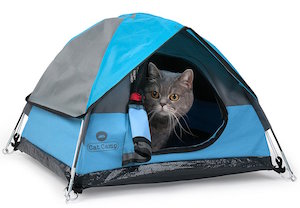 Tiny Tents For Cats
Tiny Tents For Cats
If you've ever stood in the camping section of a big box store and wondered how you could snag one of those miniature display tents for your pet, we're happy to report, the problem was solved with Cat Camp, an Australian company that created teeny tiny tents for indoor cats. The tents set up like a human-sized tent. The makers say the tiny cat tents serve as a high quality cat bed and a cozy hideaway.
Paris Goldfish Given Asylum
Goldfish in Paris get second chance to just keep swimming, so long as their owners kick them out of their tiny fish bowl homes versus flushing them down the toilet. Surrendered goldfish undergo a regimen of antibiotics and treatments while under quarantine for at least a month before being introduced to their new fish society. Because the fish are kept in much larger aquariums at the Paris Aquarium, they grow much larger at the aquarium than any fish bowl could allow, sometimes between eight and 12 inches.
 Listen to the entire Podcast of this show (#1159)
Listen to the entire Podcast of this show (#1159)





